<![CDATA[One of history's most mysterious figures, Grigori Rasputin was assassinated in St. Petersburg on 30th December, 1916. His death has become a fantastical story, with myths and exaggerations over the 99 years since likely obscuring reality. Born into a peasant family in Siberia in 1872, Rasputin would go on to become one of the most significant figures in Russia leading up to the 1917 Russian Revolution. Inevitably however, this influence saw him create a host of powerful enemies. Reaching St. Petersburg in 1903, Rasputin's reputation as a faith healer brought him into contact with the royal family, who used his talents to aid their hemophiliac son, Alexis. Over the following years, Rasputin became an increasingly visible part of the royal court, going as far as declaring himself the advisor to the Tsarina Alexandra. Other statesmen became increasingly critical of the power the peasant 'monk' from Siberia had gained, while the press and critics of the regime used him as a tool to undermine the monarchy's credibility. As more and more extreme stories of Rasputin's lascivious behaviour and penchant for debauchery filled the press, and trust in the Tsarist regime was pushed to its limit by Russia's disastrous intervention in the First World War, an increasingly large group of politicians and royals plotted to have him removed. On the evening of the 29th, a group of conspirators, including Duke Dmitri Pavlovich, one of Tsar Nicholas II's cousins, and Prince Felix Yusupov set in motion plans to have the 'mad monk' killed when they invited him to Yusupov's palace. There, Rasputin was fed with cakes and wine laced with deadly potassium cyanide. The dosage of the lethal substance should have been sufficient to kill Rasputin, but the only effect it seemed to have was to leave him inebriated. Prince Yusupov is then reported to have taken a gun from Pavlovich, and shot Rasputin. Believing him to be dead, the conspirators returned upstairs, planning to dispose of the body later in the evening. Accounts of what happened next vary, but the most popular version claims that when Yusupov returned to check on the body, Rasputin was still alive, attacked Yusupov and attempted to escape from the house while threatening to tell the Tsarina of the plot. Another of the accomplices shot Rasputin in the head as he fled across the garden. Still convulsing, Rasputin was kicked in the head until he stopped moving. His body was then returned to the house, where Yusupov then smashed the dead man's skull with a two pound dumbbell. Early in the morning of the 30th December 1916, the conspirators placed Rasputin's body in a car, and rushed to dispose of it in the Malaya Nevka River while still under the cover of darkness. Some accounts claim Rasputin was still alive when the assailants brought him to the river, but either way, the body was weighed down and then tossed into the ice. Several days later, after Rasputin's daughters had reported him missing, the police discovered the body. A hole had been smashed in the surface of the thick ice which covered the river, and the body was found floating in another hole in the ice a little further downstream. Rasputin's hands were found frozen in a raised position, leading some to argue that he had been alive in the frozen river, and had fought to escape to the surface. Of course, the story is likely to have been distorted by history, and accounts vary on exact details, but the mythology surrounding Rasputin's death is in itself indicative of the impression he left on Russian society in the years leading up to the 1917 revolution. This mythology was given further grounding with events which occured later. In an earlier letter to Tsar Nicholas II, Rasputin had written that if he were killed by officials in the Tsar's court, the entire royal family would be murdered. 15 months later, after the revolution had changed Russia forever, Rasputin's prophecy seemed to come true.]]>
Anniversary of Rasputin's Incredible Death
